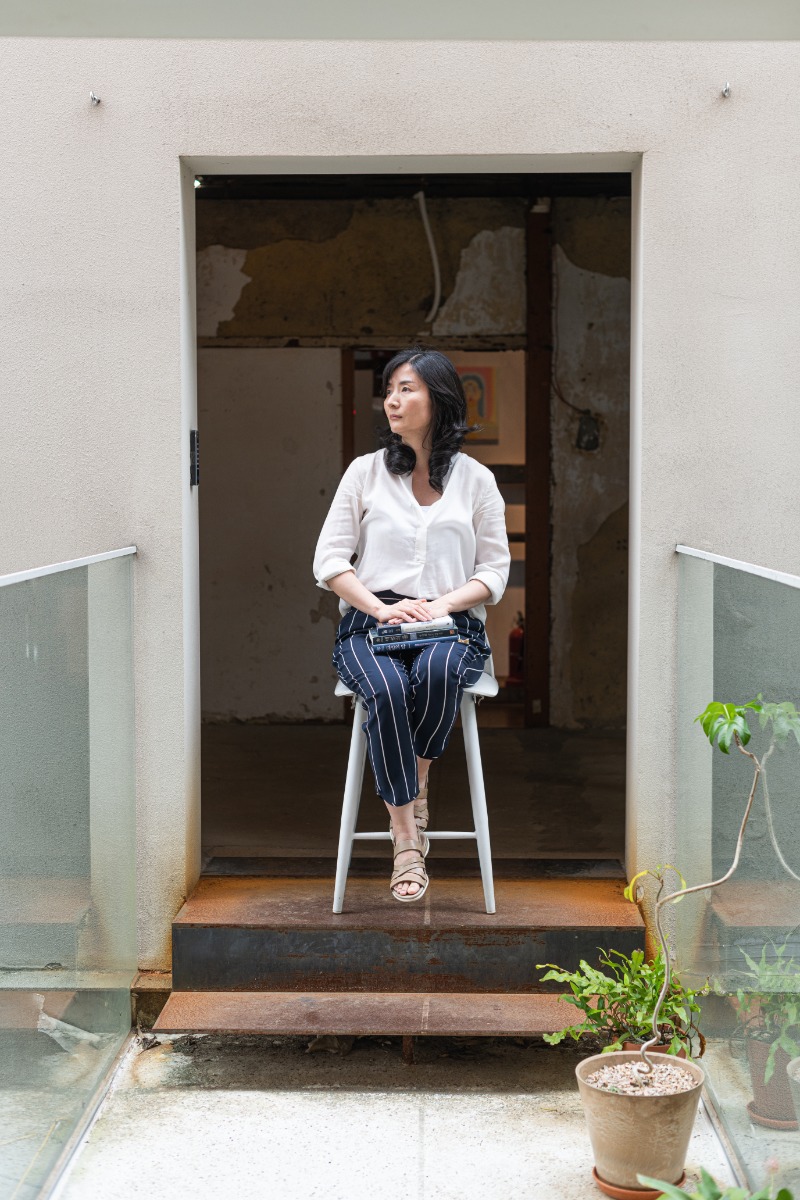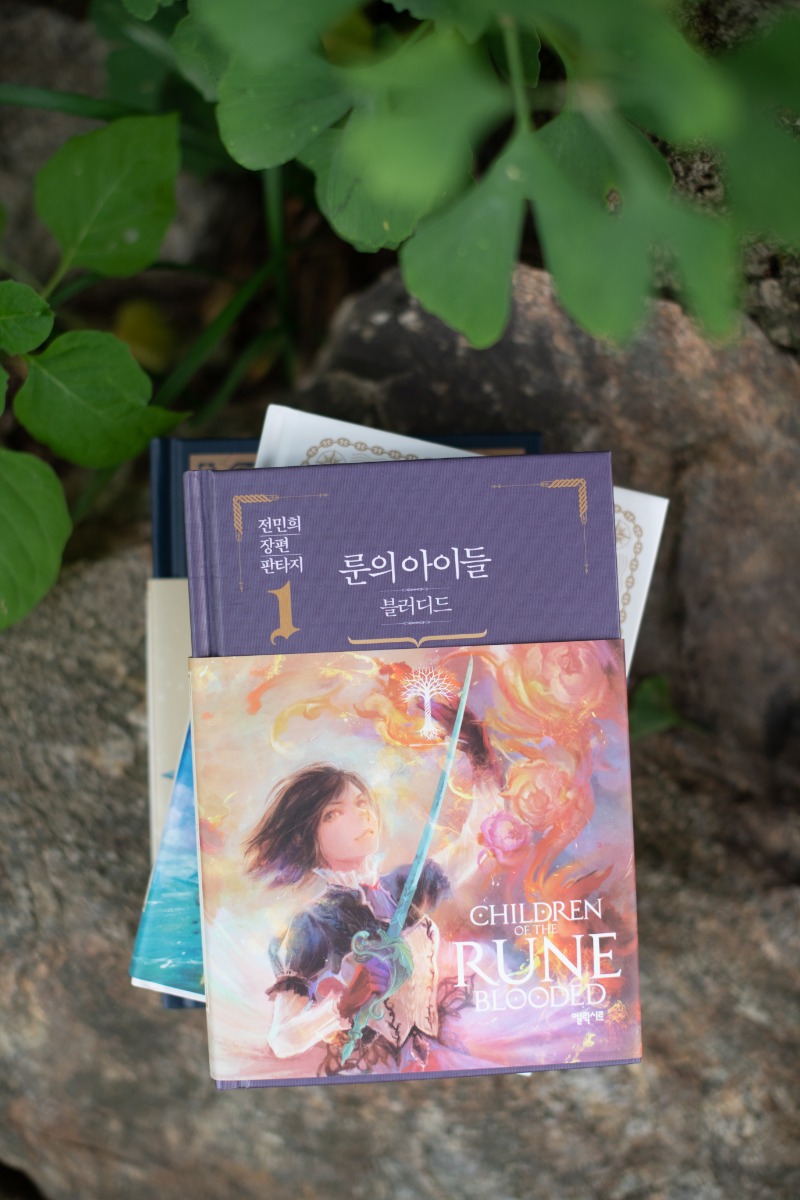Jeon Min-hee began her career among the 1990s internet vanguard of fantasy writers. Her books, often revisions of her past works, are blockbusters in China, Japan, Taiwan and Thailand, as well as at home in Korea. She took a break for an interview at a cozy café near Gyeongbok Palace, central Seoul.

Fantasy writer Jeon Min-hee made her debut in 1999 on PC network Nownuri with “The Stone of Days.” Her detailed descriptions and lyrical prose have produced an avid following at home and abroad.
No conversation about the past, present or future of Korean fantasy writing would be complete without including novelist Jeon Min-hee. Her first novel, “The Stone of Days,” dispatches Fabian, an 18-year-old store clerk, to find four jewels from a necklace he has received from his father. With a record 4 million page views on the portal site Nownuri, “The Stone of Days” remains a “legend” among diehard fantasy fans.
Jeon’s unique fantasy-world creations have devoted fans in the online gaming industry as well. Nexon’s classic 2003 RPG (role-playing game) TalesWeaver and XL Games’s 2013 RPG ArcheAge are both adaptations of her books.
Many years have passed since your debut.
I began my first series in 1999, so it’s been 23 years now. The first installment of my three-part series, “Children of the Rune,” titled “Children of the Rune – Winterer” (2001-2009), first came out in paperback in 2001, so this is also the year that “Children of the Rune” turns 20 years old.
Children of the Rune” also was a huge sensation.
Children of the Rune – Winterer” was seven volumes in total, and “Children of the Rune – Demonic” (2003-2020) came to nine volumes. In 2018, we switched publishers and put out a revised edition of the whole thing. We ran the numbers then, and while this isn’t exact, we had sold around three million copies at that point.
Why have you constantly revised your books?
Most fantasy novelists don’t like to revise their works. There are very few of us who go back and change our writing when the opportunity comes up, the way I tend to do. This is because spending that same time writing new works is generally more enjoyable, not to mention better in terms of generating new income or solidifying your reputation.
I revise and polish until I feel satisfied with the new version, but then when I look back again after more time has passed, I invariably see more things I’d like to supplement. For example, when “The Stone of Days” was re-released in 2004 by a different publisher, the parts in it that felt immature were so obvious to me that I couldn’t bear to let it go to print untouched, though of course, I did have a lot of fondness for it as my earliest work. It’s possible, though, that if I had let that go then, I wouldn’t have started returning to and revising my other works either.
“People tend to think that fantasy novels are built out of whole cloth directly from the imagination of the author, but in actuality, they have a foundation of wide-ranging research and meticulous study.”

Jeon’s signature work, “Children of the Rune,” consists of three parts: “Children of the Rune – Winterer” (2001-2019), “Children of the Rune – Demonic” (2003-2020) and “Children of the Rune – Blooded” (2018-). The storyline is about children struggling to survive and forge an identity amid post-civilization power struggles.
How have readers reacted to the revisions?
Because these revisions go beyond polishing sentences and actually involve adding in new plot points and episodes, readers’ opinions tend to be split. Some readers who felt like they now had to buy the revised editions probably felt frustrated. But the number of readers who enjoy the revised editions has gradually grown. Some readers even organize everything that’s changed and share details with one another.
Why do your stories have a lasting impression?
When I first began serializing my writing on the portal site Nownuri in my twenties, I had no real sense of my readership and just wrote whatever I wanted to. Then as my writing got surprisingly popular, it occurred to me that there must be many people whose tastes overlap with mine. That gave me the confidence to concentrate on making sure that my writing continued to be an accurate reflection of my own taste. So I let my stories grow organically, following the ideas as they came to me.
I wonder if this isn’t one of the charms inherent to fantasy as a genre. Fantasy novels aren’t limited to any single time period, after all; they have a universality and appeal that can cover and bring together multiple eras.
You balance between creating worlds and details.
People tend to think that fantasy novels are built out of whole cloth directly from the imagination of the author, but in actuality, they have a foundation of wide-ranging research and meticulous study. For example, to set a story against the backdrop of an imaginary city that doesn’t exist in real life, one must first thoroughly research the cultural history of human cities through the ages. It’s this kind of prep work that makes elaborate compositions and detailed descriptions possible.
How did you start writing fantasy novels?
started studying the genre when I was quite young. Back then, I was just writing whatever I wanted to write, but when I looked back, I realized I had been writing fantasy. I became more conscious of the genre distinction as I became active in the fantasy group on Nownuri – and that’s when I really started writing it properly.
Thinking back now, I was very lucky. The 1990s were a moment when fantasy novels were just starting to gain traction [in Korea], and there was something about the zeitgeist that just made sense to me. I think now that my personal taste happened to resonate with people who liked those kinds of stories, and that energy ended up being quite powerful.
I was a college freshman in 1994, so when I became a senior, in 1997, Korea was experiencing the [Asian] financial crisis. There were just no jobs for anyone, including recent graduates. Since there was no way for me to make money anyway, it was a chance to try my hand at something I enjoyed.
What drew you to the fantasy genre?
I think it was probably as a young child, as I made my way through a series of “world classics” intended for children. I liked stories that felt distinct and different from everything else. For example, I really loved “The Brothers Lionheart” by the Swedish author Astrid Lindgren, who also wrote the “Pippi Longstocking” series. In fact, I realized later on what a big impact that book had on “Children of the Rune – Winterer.”
What distinguishes your novels?
I don’t think I’m the right person to try and identify that. Every now and then, there will be readers who write a piece of their own critiquing my world building. For example, there are readers who categorize my works as “young adult fiction.” I think that makes sense.
These days, young adult literature has a stable place in the Korean literary market, but when I first started writing, the category didn’t even exist. There was a reason I chose young adults as my target readership. In the pre-modern period, there were coming-of-age ceremonies and rites of passage for children, and I wanted to write about a rite of passage for readers who were that age – in the process of transforming from child to adult. To me that’s the structure of “Children of the Rune – Winterer.” Children find themselves in a situation where no one can help them, not even their parents, and will ultimately come face to face with the originalthat they ran from in fear.
You must have many long-term readers as well.
The last volume of the second series of “Children of the Rune” came out in 2007, and the first volume of the third series, “Children of the Rune – Blooded,” was released in 2018. That’s a gap of over 10 years. There may well be readers who have forgotten my books in that time. Certainly, there must be readers who have grown up and gotten jobs or gotten married. But when I had a book signing at Kyobo Bookstore one snowy winter morning, more than 500 readers still showed up. I honestly couldn’t believe it. These were readers who started with “Children of the Rune – Winterer” when they were in elementary and middle school, and now they had come as adults, in their twenties and thirties.
What are your plans moving forward?
Actually, my schedule is completely packed for the coming year. I’m in the middle of a script for a new game that I’ve got to keep working on, and I’ll be continuing to write “Children of the Rune – Blooded,” as well.